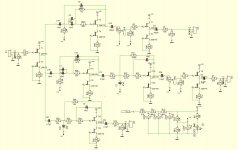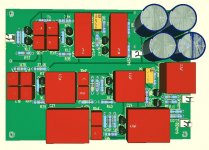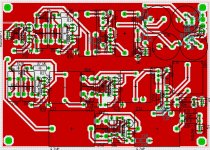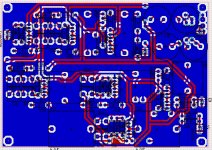Thank you, Papa, for this stunning analog crossover and the late SL for the LX Mini! (never too late to always say thank you!)
I finally got around to getting this system fired up tonight (3 years in the making for the LX Mini and 6ish months for the analog crossover)
Don't judge me! Using old school gear: Sota Saphire table, ET2 arm, Shelter 901 cartridge, Sony ES779 CD player --> Wavestream Kinetics phono tube preamp --> Wavestream Kinetics tube preamp --> ACN --> MFA 200B tube amps feeding wide range speaker and Audio Research D100B feeding woofer. Life long Magneplanar fan and various electrostatic speaker fan.
JUST WOW!
* Started listening to Drums and Bells CD by Tonian Labs to get acquainted with this new crossover / speaker setup. My older high school son plays in the advanced orchestra (marimba, xylophone, bells, other percussion "objects" and the piano). He was stunned...not quite like being in the practice percussion room at school but the wood, metal, triangle, bell kits, were flat out amazing to him. Hearing the wood and metal sound decay was beyond believe. What becomes immediately obvious with this CD is your eyes mentally tracking/skating every instrument....there is no such thing as LX speakers when you play this CD...the disappearing act is NO act. If you were blind folded and did not see these speakers, initially, and you hear the tympani struck, you would swear there are much larger speakers than what the LX Mini is producing.
I have a profound appreciation what Papa mentioned early in this thread when he was discussing with SL the canon shot in the 1812 Overture and SL was fine with this. No, you will not feel the canon shot sound reverb into your chest, but I could clearly feel the tympani through my carpeted floor rising through my socks and legs. Your in constant disbelief that this system can produce the lower 100 cycles that this system delivers, accurately.
* Next up Lincoln Mayorgoya's orchestra playing "America" from West Side Story. Once again your eyes are mentally skating every instrument with pin point location. The layers of instrument voices continues building a very nice 3D presentation....my planars and bipolar electrostats could never throw a 3D soundstage AND play tympani strikes accurately/concurrently....just wow. My younger son plays alto sax and sits not to far from the trumpet players in the intermediate orchestra band....he was equally amazed at the up front and to the right trumpets with increasing dynamic Forte Forte....we had to turn the volume down on this! This was like sitting first audience row with the trumpets out front and hitting you!
* Finally, I played Hiromi Uehara's "Tom and Jerry"... the explosive speed and attack in her playing style yet hearing every note played at speed...for me as a "hack" piano classical and jazz amateur....was stunning. This only made me appreciate how gifted she already is...but to hear this played on this system....amazing tones, crescendos, and legatos...even the delicate piano piano notes edifying "Jerry" scurrying about became realistic and made me laugh out loud visually imagining Jerry running around!
I have to go through my entire music collection with these speakers and crossover!
I just cannot say enough about these speakers and crossover given the entire family (wife plays violin) plays instruments and to mentally eye and hear skate instruments with such authenticity.
Thank you! Thank you! Thank you!
I finally got around to getting this system fired up tonight (3 years in the making for the LX Mini and 6ish months for the analog crossover)
Don't judge me! Using old school gear: Sota Saphire table, ET2 arm, Shelter 901 cartridge, Sony ES779 CD player --> Wavestream Kinetics phono tube preamp --> Wavestream Kinetics tube preamp --> ACN --> MFA 200B tube amps feeding wide range speaker and Audio Research D100B feeding woofer. Life long Magneplanar fan and various electrostatic speaker fan.
JUST WOW!
* Started listening to Drums and Bells CD by Tonian Labs to get acquainted with this new crossover / speaker setup. My older high school son plays in the advanced orchestra (marimba, xylophone, bells, other percussion "objects" and the piano). He was stunned...not quite like being in the practice percussion room at school but the wood, metal, triangle, bell kits, were flat out amazing to him. Hearing the wood and metal sound decay was beyond believe. What becomes immediately obvious with this CD is your eyes mentally tracking/skating every instrument....there is no such thing as LX speakers when you play this CD...the disappearing act is NO act. If you were blind folded and did not see these speakers, initially, and you hear the tympani struck, you would swear there are much larger speakers than what the LX Mini is producing.
I have a profound appreciation what Papa mentioned early in this thread when he was discussing with SL the canon shot in the 1812 Overture and SL was fine with this. No, you will not feel the canon shot sound reverb into your chest, but I could clearly feel the tympani through my carpeted floor rising through my socks and legs. Your in constant disbelief that this system can produce the lower 100 cycles that this system delivers, accurately.
* Next up Lincoln Mayorgoya's orchestra playing "America" from West Side Story. Once again your eyes are mentally skating every instrument with pin point location. The layers of instrument voices continues building a very nice 3D presentation....my planars and bipolar electrostats could never throw a 3D soundstage AND play tympani strikes accurately/concurrently....just wow. My younger son plays alto sax and sits not to far from the trumpet players in the intermediate orchestra band....he was equally amazed at the up front and to the right trumpets with increasing dynamic Forte Forte....we had to turn the volume down on this! This was like sitting first audience row with the trumpets out front and hitting you!
* Finally, I played Hiromi Uehara's "Tom and Jerry"... the explosive speed and attack in her playing style yet hearing every note played at speed...for me as a "hack" piano classical and jazz amateur....was stunning. This only made me appreciate how gifted she already is...but to hear this played on this system....amazing tones, crescendos, and legatos...even the delicate piano piano notes edifying "Jerry" scurrying about became realistic and made me laugh out loud visually imagining Jerry running around!
I have to go through my entire music collection with these speakers and crossover!
I just cannot say enough about these speakers and crossover given the entire family (wife plays violin) plays instruments and to mentally eye and hear skate instruments with such authenticity.
Thank you! Thank you! Thank you!
Last edited:
Purpose of the Vref?
What is the purpose of Vref? i didn't recognized any explanation. i think it's an rcr-pi-filter to lower the noise(?) . but how to integrate it in the calculation of the filter?
i want to use the topology for a 3way active crossover (2000hz 2nd order/150hz 3n order)...
What is the purpose of Vref? i didn't recognized any explanation. i think it's an rcr-pi-filter to lower the noise(?) . but how to integrate it in the calculation of the filter?
i want to use the topology for a 3way active crossover (2000hz 2nd order/150hz 3n order)...
as promised: my try of drawing the crossover. It's a 3way crossover. the values of the caps were chosen, because they are laying around on my workbench.
the topology is butterworth/multible feedback/2nd order.
i`ve chosen the multible feedback because, i had build a xenover with sallen-key topology and had the problem, of signal-rising at higher frequencies at the lowpass-filters.
the values of the resistors for the jfets are not the real values, they are just drawn as a placeholder for the board.
the lowpass-fitler for the bass got no poti, because it is the quietest part of the loudspeaker (as obviously always).
the whole thing will be used in a loudspeaker called "heartbeat" from hobbyhifi. a german magazine for building loudspeaker. the active crossover will replace the passiv crossover of the original build. it will be driven by f5v3 for the bass and mofo for mid and twetter.
i will be happy for thought, ideas and threats
the topology is butterworth/multible feedback/2nd order.
i`ve chosen the multible feedback because, i had build a xenover with sallen-key topology and had the problem, of signal-rising at higher frequencies at the lowpass-filters.
the values of the resistors for the jfets are not the real values, they are just drawn as a placeholder for the board.
the lowpass-fitler for the bass got no poti, because it is the quietest part of the loudspeaker (as obviously always).
the whole thing will be used in a loudspeaker called "heartbeat" from hobbyhifi. a german magazine for building loudspeaker. the active crossover will replace the passiv crossover of the original build. it will be driven by f5v3 for the bass and mofo for mid and twetter.
i will be happy for thought, ideas and threats
Attachments
Thanks for reminding me. BAF and numerous other commitments bumped
the project, and I intend to wrap it up shortly.
I wandered around the shelves for a bit and found the stuffed version
V2R2, awaiting only documentation and the decision as to whether to
use pc mount rca's or have the DIYers wire it into a chassis with connectors.
Any thoughts on that?
the project, and I intend to wrap it up shortly.
I wandered around the shelves for a bit and found the stuffed version
V2R2, awaiting only documentation and the decision as to whether to
use pc mount rca's or have the DIYers wire it into a chassis with connectors.
Any thoughts on that?
Thanks for reminding me. BAF and numerous other commitments bumped
the project, and I intend to wrap it up shortly.
I wandered around the shelves for a bit and found the stuffed version
V2R2, awaiting only documentation and the decision as to whether to
use pc mount rca's or have the DIYers wire it into a chassis with connectors.
Any thoughts on that?
The pcb rca's are a great option! Reduces the profile; shortens the connections and tidies the signal inputs/outputs
On the other hand, who wants different signal connectors can wire them. So i think is a win-win solution.
i will be happy for thought, ideas and threats
I guess you have to re-check your whole layout again: Every stage needs a ref voltage on the gate of the fet, since you use a single supply voltage. Please re-read Nelson's original schematic. (The potentiometers should also be kept out of the DC biased parts.)
"... VREFis a DC value to set the operating point of the single-ended circuits. ..."
I’m currently using a xilica xp30-60 a marchand xm46 passive active crossover that uses inductors and caps and a straight passive network. With this new crossover I can all the options lol. I have some b&g neo 10 neo 3 dipoles and some large eliptical cnc wood horns I use interchangeable on top of a dual 15” woofer cabnet. I just swap the crossovers and drivers in and out depending on if I’m gonna Listen to acoustic or blues/ rock.
- Home
- Amplifiers
- Pass Labs
- LX-mini Crossover Article




